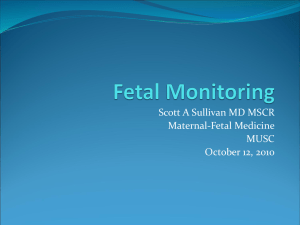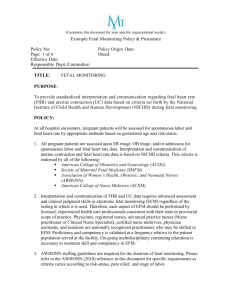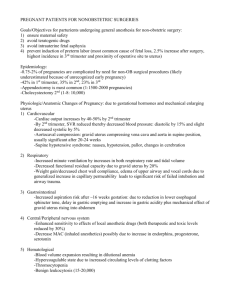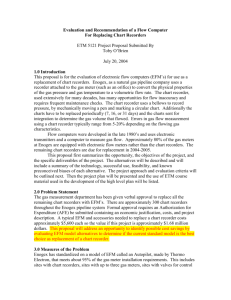Does Electronic Fetal Monitoring Increase CS Rate
advertisement
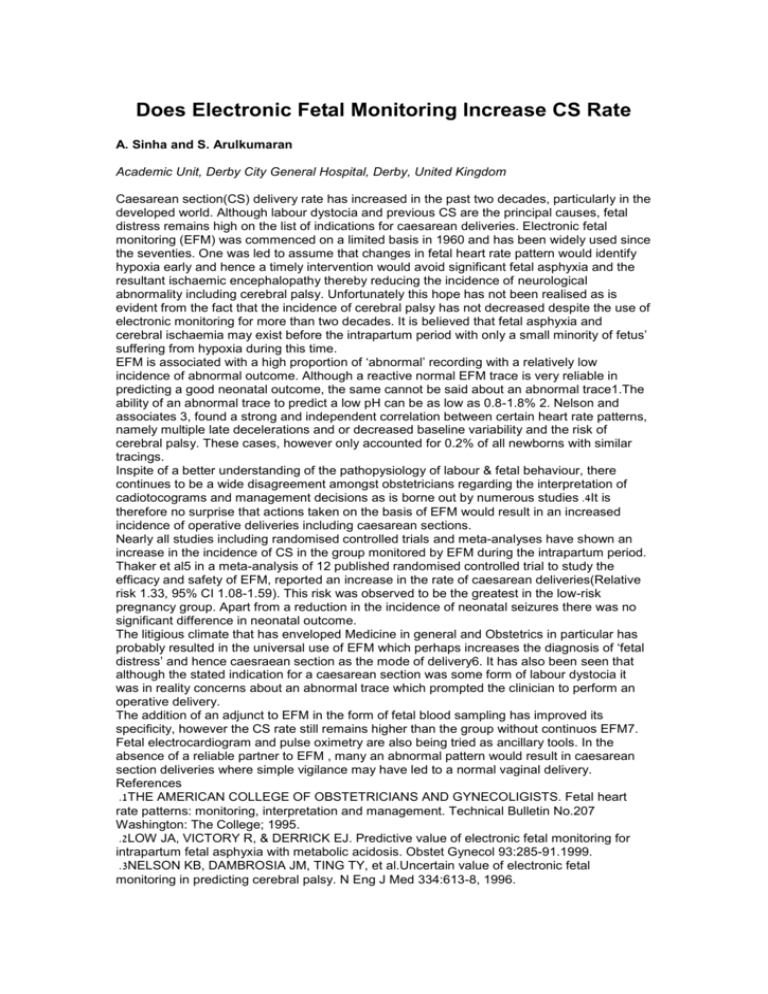
Does Electronic Fetal Monitoring Increase CS Rate A. Sinha and S. Arulkumaran Academic Unit, Derby City General Hospital, Derby, United Kingdom Caesarean section(CS) delivery rate has increased in the past two decades, particularly in the developed world. Although labour dystocia and previous CS are the principal causes, fetal distress remains high on the list of indications for caesarean deliveries. Electronic fetal monitoring (EFM) was commenced on a limited basis in 1960 and has been widely used since the seventies. One was led to assume that changes in fetal heart rate pattern would identify hypoxia early and hence a timely intervention would avoid significant fetal asphyxia and the resultant ischaemic encephalopathy thereby reducing the incidence of neurological abnormality including cerebral palsy. Unfortunately this hope has not been realised as is evident from the fact that the incidence of cerebral palsy has not decreased despite the use of electronic monitoring for more than two decades. It is believed that fetal asphyxia and cerebral ischaemia may exist before the intrapartum period with only a small minority of fetus’ suffering from hypoxia during this time. EFM is associated with a high proportion of ‘abnormal’ recording with a relatively low incidence of abnormal outcome. Although a reactive normal EFM trace is very reliable in predicting a good neonatal outcome, the same cannot be said about an abnormal trace1.The ability of an abnormal trace to predict a low pH can be as low as 0.8-1.8% 2. Nelson and associates 3, found a strong and independent correlation between certain heart rate patterns, namely multiple late decelerations and or decreased baseline variability and the risk of cerebral palsy. These cases, however only accounted for 0.2% of all newborns with similar tracings. Inspite of a better understanding of the pathopysiology of labour & fetal behaviour, there continues to be a wide disagreement amongst obstetricians regarding the interpretation of cadiotocograms and management decisions as is borne out by numerous studies .4It is therefore no surprise that actions taken on the basis of EFM would result in an increased incidence of operative deliveries including caesarean sections. Nearly all studies including randomised controlled trials and meta-analyses have shown an increase in the incidence of CS in the group monitored by EFM during the intrapartum period. Thaker et al5 in a meta-analysis of 12 published randomised controlled trial to study the efficacy and safety of EFM, reported an increase in the rate of caesarean deliveries(Relative risk 1.33, 95% CI 1.08-1.59). This risk was observed to be the greatest in the low-risk pregnancy group. Apart from a reduction in the incidence of neonatal seizures there was no significant difference in neonatal outcome. The litigious climate that has enveloped Medicine in general and Obstetrics in particular has probably resulted in the universal use of EFM which perhaps increases the diagnosis of ‘fetal distress’ and hence caesraean section as the mode of delivery6. It has also been seen that although the stated indication for a caesarean section was some form of labour dystocia it was in reality concerns about an abnormal trace which prompted the clinician to perform an operative delivery. The addition of an adjunct to EFM in the form of fetal blood sampling has improved its specificity, however the CS rate still remains higher than the group without continuos EFM7. Fetal electrocardiogram and pulse oximetry are also being tried as ancillary tools. In the absence of a reliable partner to EFM , many an abnormal pattern would result in caesarean section deliveries where simple vigilance may have led to a normal vaginal delivery. References .1THE AMERICAN COLLEGE OF OBSTETRICIANS AND GYNECOLIGISTS. Fetal heart rate patterns: monitoring, interpretation and management. Technical Bulletin No.207 Washington: The College; 1995. .2LOW JA, VICTORY R, & DERRICK EJ. Predictive value of electronic fetal monitoring for intrapartum fetal asphyxia with metabolic acidosis. Obstet Gynecol 93:285-91.1999. .3NELSON KB, DAMBROSIA JM, TING TY, et al.Uncertain value of electronic fetal monitoring in predicting cerebral palsy. N Eng J Med 334:613-8, 1996. .4NEILSEN PV, STIGSBY B, NICKELSEN C, NIM J. Intra- and interobserver variability in the assessment of cardiotocograms. Acta Obstet Gynecol Scand 66:421-4, 1987. .5THAKER SB, STROUP DF, PETERSON HB. Efficacy and safety of intrapartum electronic fetal monitoring : an update. Obstet Gynecol 86: 613-20, 1995. .6TUSSING AD, WOJTOWYCZ MA. Malpractice, defensive medicine, and obstetric behavior. Med Care 35:172-91, 1997. .7NEILSON JP. Cardiotocography during labour. BMJ 306: 347-8, 1993.




